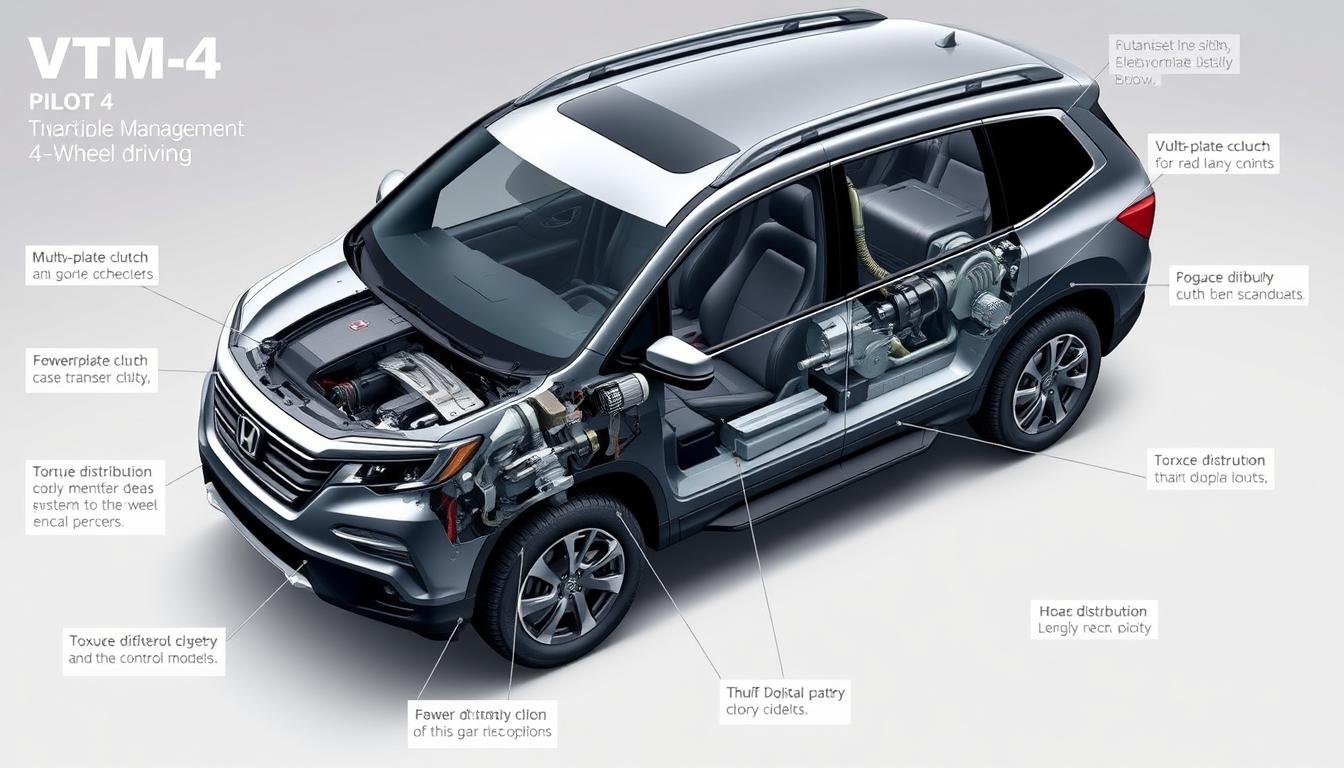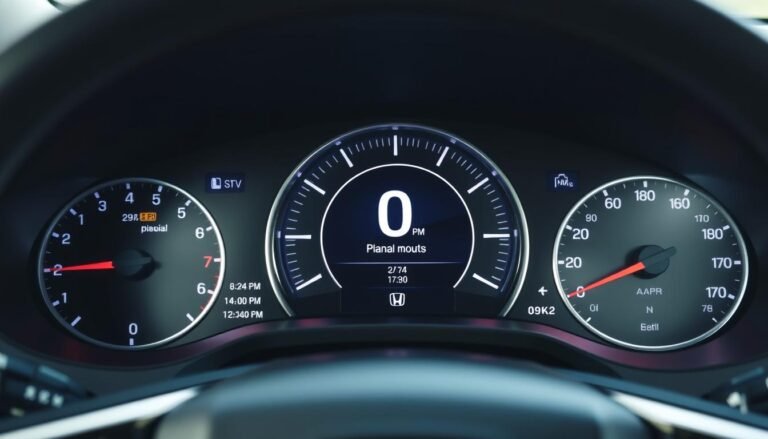What Does Vtm-4 Mean on A Honda Pilot? Light Explained For Owners
What does VTM-4 mean on a Honda Pilot? It stands for Variable Torque Management 4-wheel drive.
This system boosts traction and improves your drive, especially on difficult roads. Knowing about this helps when you see the VTM-4 light on your dashboard.
The VTM-4 light is an important warning. It tells you about the status of the Honda Pilot AWD system. When this light comes on, your car may need some care.
In this guide, we’ll explore what VTM-4 means and how it works. It’s key for keeping a good grip on slippery roads.
We will show how to fix any issues with the VTM-4 light too. This knowledge lets you handle many driving conditions confidently in your Honda Pilot.
Introduction To VTM-4 in Honda Pilot
VTM-4 is a big step forward in making the Honda Pilot better for all kinds of roads. This all-wheel-drive (AWD) technology, made by Honda, is all about boosting grip and steadiness.
Honda’s move to include VTM-4 in the Pilot shows its dedication to top-notch performance for various drive conditions.
VTM-4 first came out in the late 1990s as Honda aimed to upgrade its cars for ever-changing roads.
The system has special features, allowing it to send power to the back wheels when it’s needed the most. This boosts control and handling.
So, the Honda Pilot works better in rain, mud, or when off-roading because of VTM-4.
So, VTM-4 in the Honda Pilot isn’t just about new tech; it’s about making driving safer and more fun.
As you read on, you’ll learn more about how VTM-4 works. You’ll see why it’s key for a great ride.
What Does VTM-4 Mean on A Honda Pilot?
For Honda Pilot owners, knowing what VTM-4 means is crucial for getting the most out of their car. VTM-4 stands for Variable Torque Management 4-wheel drive.
It’s all about improving traction. By balancing the torque between the front and rear axles, it ensures your car grips the road well.
What’s The Acronym VTM-4?
VTM-4 is a key part of the Honda AWD system. It stands for “Variable Torque Management.” This means the system can change how it spreads out power depending on the need.
So, no matter the situation, your car sends power to the right wheels for better safety and control.
The Role of VTM-4 in Honda’s AWD System
In the Honda Pilot, VTM-4 is essential for the AWD system to work its magic. It smartly shares out torque which improves how the car handles and stays stable.
This is especially true on slippery or rough roads. As the driver, you get a smoother, safer ride because your car adapts to different road conditions.
VTM-4 System Explained
The VTM-4 system helps the Honda Pilot handle better by controlling how it uses power.
It makes sure the power goes where it’s needed for the best grip. This way, whether the road is dry or wet, you know your car is ready.
When a wheel starts to slip, the system shifts power to the wheel with more grip. This improves stability and lets you drive safely.
How The VTM-4 System Operates?
The VTM-4 system uses an electronic part to change power between wheels when needed. This helps the car adapt on the fly.
It’s great for tough roads, steep hills, or bad weather. This system means better control when you’re carrying heavy stuff or towing.
Comparison with Other Honda AWD Systems
VTM-4 stands out against the Real Time AWD in some Honda models. It’s better at moving power around.
Real Time AWD waits for wheels to slip before acting, but VTM-4 is ahead of the game. This makes driving smoother in different conditions.
Honda Pilot VTM-4 Function
The Honda VTM-4 system is key for better driving performance and safety. It improves how torque is shared in the Honda Pilot.
This affects how the car handles and stays stable, especially in tough conditions. Knowing how it works can make driving more enjoyable.
Torque Distribution Features
Honda Pilot’s torque distribution lets the car give power to the wheels needing it most. This is useful in bad weather like rain or snow, or on rough roads.
It manages power to each wheel, boosting grip. This lessens slipping chances and makes driving secure.
How VTM-4 Enhances Driving Experience?
VTM-4 changes how the Honda Pilot drives by moving easily between two-wheel and four-wheel drive.
This means the Pilot works well on different roads, including off-road. When roads get slippery or uneven, the system steps in.
It brings better stability and control. Drivers know this tech keeps them safe and boosts their car’s performance.

VTM-4 All-Wheel Drive System
The VTM-4 all-wheel drive system enhances the Honda Pilot’s drive. It boosts your confidence on the road, especially in tough conditions.
This technology ensures better handling, safety, and traction. It’s something Honda Pilot drivers will find very useful.
Benefits of All-Wheel Drive in Honda Pilot
- Improved Traction: By distributing power to all four wheels, it greatly improves grip on challenging surfaces like ice or mud.
- Enhanced Stability: The VTM-4 system adjusts torque to help keep the car in control. This is helpful in sharp turns or quick actions.
- Increased Safety: All-wheel drive brings a feeling of safety in bad weather. It helps you drive with confidence in rain or snow.
- Better Off-Road Capability: The VTM-4 shines off-road, making it perfect for adventures on different types of terrain.
VTM-4’s Impact on Traction and Stability
The VTM-4 all-wheel drive’s benefits are not just for normal driving. It senses when more traction is needed, ensuring a stable and controlled drive.
By powering the rear wheels when needed, VTM-4 guarantees top traction and stability, even on tricky roads.
Honda Pilot VTM-4 Features
The Honda Pilot’s VTM-4 system stands out with its advanced features. It has a lock mode that boosts torque distribution in tough conditions.
This means better traction and stability when you’re driving off-road or in bad weather. You’ll feel more confident during your adventures.
VTM-4 uses smart sensors to watch wheel spin and share torque where it’s needed. This keeps the car performing well on different terrains.
Thanks to these sensors, your drive is smooth and reliable. Getting to know the Honda Pilot’s specs shows how efficient VTM-4 is.
Remember, regular check-ups are vital for it to work well. Keep an eye on fluid levels and follow maintenance tips from the manufacturer.
By doing so, you’ll get the best out of your Honda Pilot’s VTM-4 system.
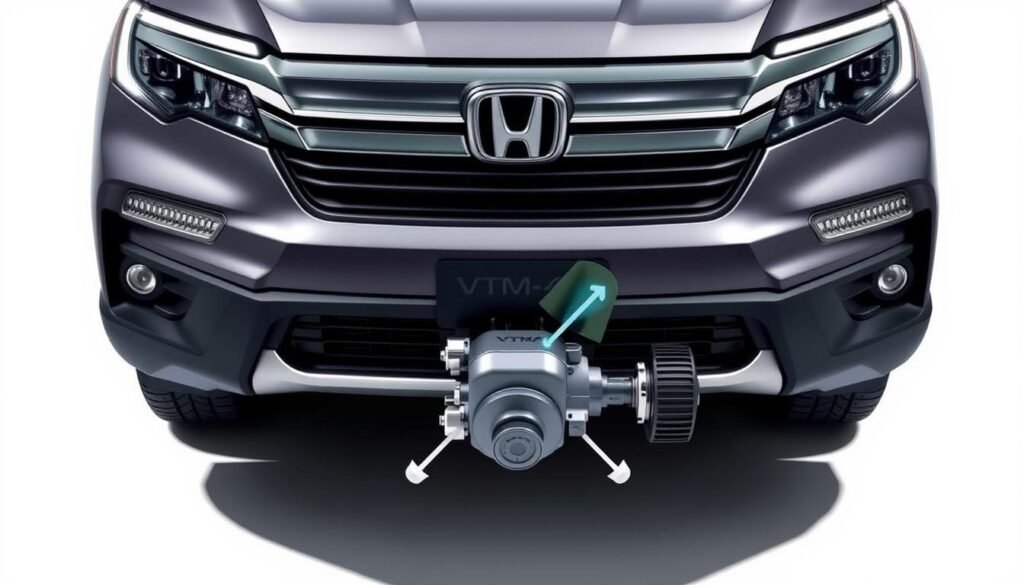
Knowing VTM-4 on Honda Pilot
If you own a Honda Pilot, knowing about VTM-4’s common issues is vital. Spotting early warning signs helps tackle problems quickly.
Being aware keeps your car running smoothly, a big part of being a responsible driver.
Common Issues and Warning Signs
The VTM-4 system in your car might face some troubles that impact how well it works. Issues that often come up include:
- Illuminated VTM-4 light on the dashboard
- Difficulty in engaging or disengaging the all-wheel-drive feature
- Unusual engine noises when using the VTM-4
- Slipping or inconsistent power delivery to the wheels
Seeing any of these signs means it’s time to act to prevent bigger problems.
Driver Responsibilities with VTM-4
Driving a Honda Pilot means more than just steering the wheel. Consistent maintenance is key to keeping the VTM-4 in good shape.
Here are main things to do:
- Periodically check the VTM-4 fluid level and quality.
- Adhere to manufacturer-recommended service intervals.
- Be attentive to any unusual sounds or warning lights.
- Consult your owner’s manual for specific guidelines on VTM-4 maintenance.
By being proactive and knowledgeable, you’ll handle VTM-4 issues well and keep your Honda Pilot at its best.
Why is The VTM-4 Light On My Honda Pilot Illuminated?
Seeing the VTM-4 light on your Honda Pilot can make you worry. It tells you about different possible problems.
Learning the VTM-4 light causes is crucial. Simple issues like low fluid levels or a small system glitch can turn on the light.
But, it could also mean something big, like a bad rear differential or broken pieces. Knowing these problems helps you fix them quickly.
Potential Causes of Illumination
There are a few reasons why the VTM-4 light comes on. Each reason shows how urgent the problem might be:
- Low transmission fluid levels.
- Faulty sensors within the AWD system.
- Issues with the rear differential.
- Malfunctioning electronic control units (ECUs).
- Blocked or damaged wiring connectors.
Models Affected by VTM-4 Issues
Different Honda models VTM-4 problems have been noted, mainly in the Honda Pilot. The first three generations have distinct issues:
| Generation | Common Issues |
|---|---|
| First (2003-2008) | Transmission fluid leaks and sensor failures. |
| Second (2009-2015) | Rear differential wear and electronic control issues. |
| Third (2016-Present) | Sensor calibration problems and fluid sensor inaccuracies. |
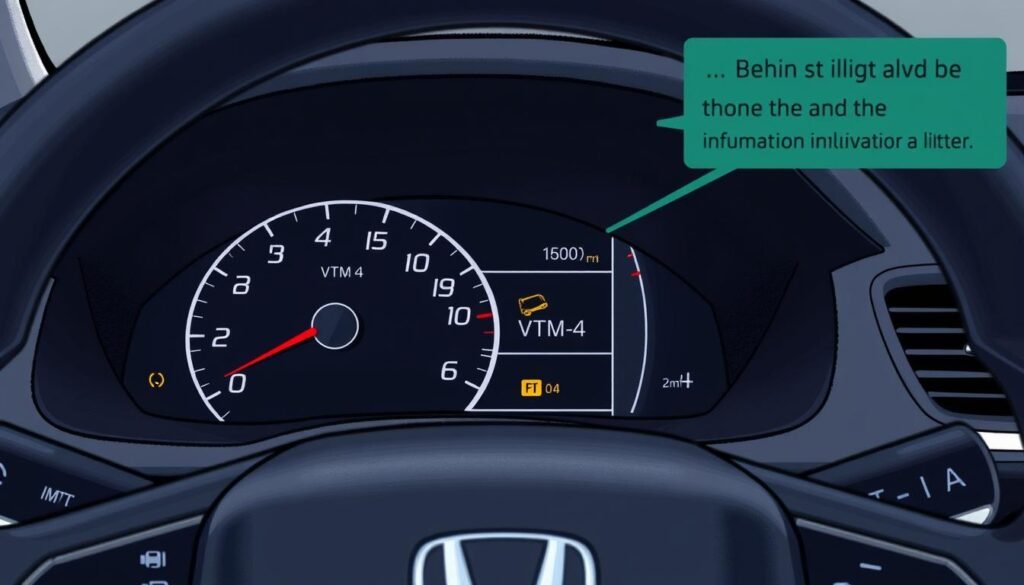
What To Do When My Honda Pilot VTM-4 Light is Flashing?
If you see the VTM-4 light on your Honda Pilot flashing, it’s important to act quickly. This will help avoid any harm to your vehicle.
Follow these key steps for proper VTM-4 flashing light troubleshooting. First, move to a safe spot as soon as you can. Driving with the light flashing might make things worse.
After you stop, shut off the engine and wait a minute. This break helps reset the system, possibly fixing small problems.
Restart the engine after waiting. Check the VTM-4 light. If it’s not flashing, you can drive again but stay careful.
A flashing light still means there’s a serious issue that needs quick help. Then, look in your owner’s manual for help with the VTM-4 system.
It has important info on what the flashing light means for your car. If the light doesn’t stop flashing, take your Honda Pilot to a skilled mechanic or a Honda dealer.
Ignoring the flashing light could cause bigger problems and affect how your car runs. Quick action can help save both time and money.
| Step | Action | Purpose |
|---|---|---|
| 1 | Pull over safely | Avoid further complications |
| 2 | Turn off the engine | Allow system reset |
| 3 | Restart the engine | Check the VTM-4 light status |
| 4 | Consult owner’s manual | Get model-specific guidance |
| 5 | Visit a certified mechanic | Obtain professional diagnosis |
Can I Drive My Honda Pilot with The VTM-4 Light On?
Driving with the VTM-4 light on in your Honda Pilot needs care. It’s important to know what the light means.
A steady VTM-4 light usually means the all-wheel-drive is on or there’s a small issue. You can still drive, but keep an eye on how your car is doing.
If the VTM-4 light blinks, it’s serious. It means something is really wrong with the system that might make driving risky.
You should stop driving right away to prevent big repairs or dangerous situations. Watch out for strange sounds or if your car feels different when driving.
To sum it up, driving with a steady VTM-4 light is okay, just be careful. But if it starts to blink, stop driving to keep safe. Being careful can protect you and your Honda Pilot for a long time.
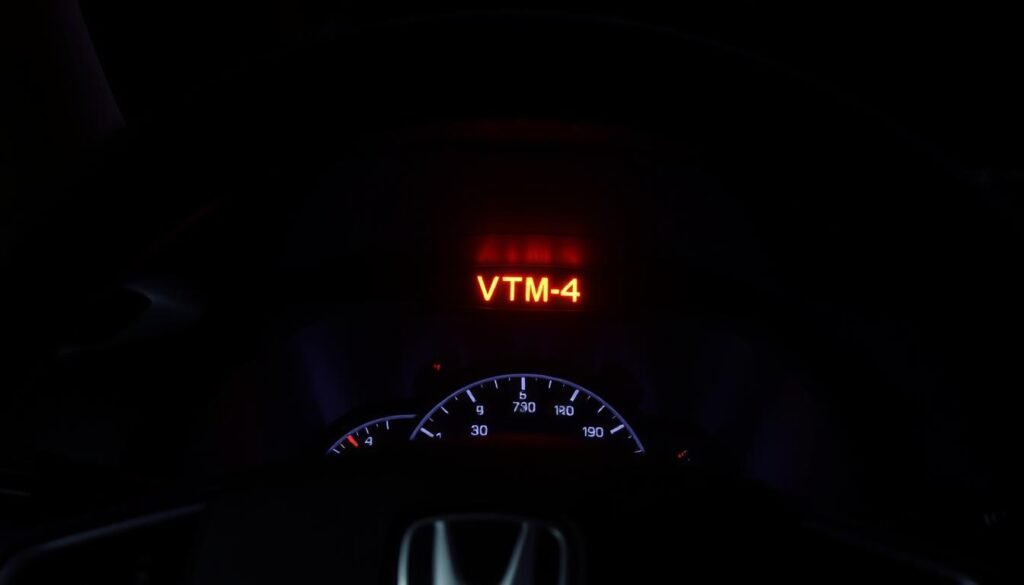
How To Turn Off A Honda Pilot VTM-4 and/or Check Engine Light?
If the VTM-4 or check engine light flashes on your Honda Pilot, it’s best to take care of it quickly. Here are steps for proper maintenance to possibly turn off the VTM-4 light.
- Inspect the Fluid Levels: Make sure the transmission and differential fluids are full. If they’re low, it might cause the VTM-4 light to come on.
- Examine the Sensors: Bad wheel speed sensors or a VTM-4 sensor can set off warning lights. It’s a good idea to check these parts for damage.
- Reset the System: Unplug the battery for 10 to 15 minutes. This action can reset the system and may switch off the VTM-4 light.
- Look for Diagnostic Codes: Use an OBD-II scanner to find any error codes. This scanner helps find problems with your Honda Pilot.
- Seek Professional Help: If you’ve tried these steps and the VTM-4 warning still shows, you should get help from a certified mechanic for more tests.
Conclusion
For Honda Pilot owners, knowing how VTM-4 works is key to better driving. This system improves grip and steadiness on tough roads.
It sends power to the right wheels, making drives smoother and more stable. To keep the VTM-4 system in top shape, regular checks are a must.
Knowing the signs of trouble helps avoid big problems later. Taking care of your Honda Pilot this way means safer and more fun drives.
Learning to use VTM-4 means you can drive your Honda Pilot with more confidence. With the right know-how, you’ll enjoy better driving and your car will perform its best.
FAQs
Q: What does the VTM-4 system do in a Honda Pilot?
A: VTM-4 stands for Variable Torque Management 4-wheel drive. It improves traction by sending power to the front and rear axles as needed. This helps the Honda Pilot perform better on tough roads.
Q: How can I tell if there is a problem with my Honda Pilot’s VTM-4 system?
A: If there’s an issue, the VTM-4 light on your dashboard will light up. This can show minor or serious problems. It could mean issues with the rear differential or the system.
Q: What should I do if the VTM-4 light is flashing?
A: When the VTM-4 light flashes, stop safely to check. Neglecting a flashing light can harm your car. You might need to check the car’s systems or see a mechanic.
Q: What are the benefits of the VTM-4 all-wheel drive system for my Honda Pilot?
A: The VTM-4 system boosts traction and stability. It’s great in bad weather, improving control and safety on slippery or rough roads.
Q: Is it safe to drive my Honda Pilot with the VTM-4 light on?
A: It’s risky to drive with the VTM-4 light on. A steady light could mean a small issue. But a flashing light means there’s a serious problem that needs quick action. Get professional help if you’re not sure.
Q: What maintenance is required for the VTM-4 system?
A: Keep the differential fluid checked and make sure VTM-4 parts work well. Watching warning lights and fixing problems quickly helps keep the system good for longer.
Q: How does the VTM-4 compare to Honda’s Real Time AWD system?
A: The VTM-4 system gives more immediate torque distribution than the Real Time AWD. This makes it better for challenging terrains thanks to enhanced control and performance.

